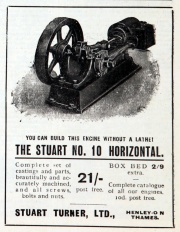Stuart Turner and Co

































Stuart Turner and Co of Henley-on-Thames.
General
See Sidney Marmaduke Stuart-Turner
1906 Stuart Turner Ltd was incorporated and started to produce model steam engines, gas engines for domestic electricity, lathes, etc. Stuart Turner went on to produce further designs, and by the end of 1906 there were nine models in the range.
By 1907 more space was needed so premises were rented at Market Place, Henley-On-Thames where the company remained for many years.
In 1911, the Stuart Stella motorcycle was introduced, including a two-cylinder water cooled two-stroke engine.
In 1914, the company manufactured a generating plant for the Antarctic explorer Ernest Shackleton's ship, the Endurance. It was used in the ill-fated Imperial Trans-Antarctic Expedition.
WWII During World War I (1914–18), the company produced nuts and bolts, gas valves and a Klaxon horn for gas attack warnings. The workforce expanded to over 300 men and 100 women.
In 1917, Stuart Turner acquired Broadgates Inn in Market Place, Henley-on-Thames, and has used this as a base ever since.
1944 Producing a tiny 2-3 bhp two stroke diesel engine for marine use
A decision was taken in the late 1980s to separate Stuart Turner Ltd. into two separate operations with the larger side of the business making pumps staying at Henley-on-Thames, Oxfordshire, England, and the Steam Engine section moving to Cheddar in Somerset.
In 1991, Stuart Models underwent a change of ownership with the production and sales departments moving to Guernsey.
Engines
See Stuart Turner and Co: Engines
Generating Sets
See Stuart Turner and Co: Generating Sets
Pumps
See Stuart Turner and Co: Pumps
Stuart Motorcycle
1911 R. G. Nye and Co of London first showed this make at the Olympia show, late in the year. It was fitted with a 2.5hp 299cc two-stroke engine with internal flywheels with aluminium plates to raise the primary compression. It had some very modern design features, including a non-return valve in the inlet tract, and compression release connected to the exhaust pipe. Chain-driven Bosch magneto, Druid forks and belt drive completed the outfit.
1912 Late in the year came another engine - a 784cc water-cooled in-line-twin two-stroke. This drove back through a clutch to an indirect two-speed gearbox that stepped the drive for a shaft to run back to a worm at the rear wheel. It also used pressure lubrication and Druid forks.
Stellar Motorcycle
Stellar was a motorcycle produced between 1912 and 1913 with sales handled by R. G. Nye and Co of Hampstead Road, London.
The machine was first listed as the Stuart and then as the Stella before being listed late in 1912 as the Stellar. It had a 784cc water-cooled, in-line-twin, two-stroke engine, with a clutch to an all-indirect two-speed gearbox, Bosch magneto, Amac carburettor and a kick-start pedal. The engine and gearbox fitted between the downtube and saddle tube of the sprung-forked frame. Although the design was interesting, it had little public appeal, so nothing further came of the venture.
Note: It was variously listed as the Stella and the Stellar, but nothing further came of it.
See Also
Sources of Information
- The British Motorcycle Directory - Over 1,100 Marques from 1888 - by Roy Bacon and Ken Hallworth. Pub: The Crowood Press 2004 ISBN 1 86126 674 X
- The Encyclopedia of the Motorcycle by Peter Henshaw. Published 2007. ISBN 978 1 8401 3967 9
- [1] Wikipedia
- The Modern Diesel edited by Geoffrey Smith. Published by Iliffe & Sons 1944

